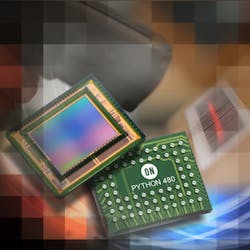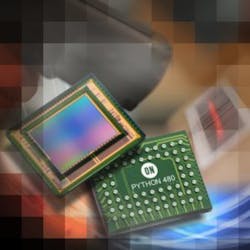ON Semiconductor’s PYTHON 480 sensor allows drones to avoid collisions
The 1/3.6-inch SVGA CMOS image sensor with its large, highly sensitive 4.8-µm pixels enables the capture of moving objects without any artifacts with single-digit noise performance. It provides a high SVGA frame rate of 120 fps with a compact CSP package and a small footprint. This allows a very small camera design and significant power saving, as well a battery-powered mobile operation. These features are especially suitable for eyes of robots, surveillance systems, and unmanned aerial vehicles. Up to four regions of interest can be programmed, achieving higher frame rates for special focused areas. A separate synchronization channel containing payload information is provided to facilitate the image reconstruction at the receiving end. The device provides a high speed serial or parallel CMOS output.
Sibel Yorulmaz-Cokugur, ON Semiconductor’s line manager at FRAMOS, explains the 480 sensor’s unique features and customer applications benefits: “The 480 has improved image and recognition quality. The highly sensitive pixels support low-noise ‘pipelined’ and ‘triggered’ global shutter readout modes. Furthermore, the correlated double sampling (CDS) support in global shutter mode results in reduced noise and increased dynamic range. A high level of programmability allows the reconfiguration of integration time and gain-parameters by on-chip programmable gain-amplifiers and 10-bit A/D converters without any visible image artifact. Optionally, the on-chip automatic exposure control loop (AEC) controls these parameters dynamically. The image’s black level is either calibrated automatically, or adjusted by adding a user-programmable offset.”
Engineering samples of the PYTHON 480 will be available in monochrome and Bayer color configurations in early 2017. Industry and product experts at FRAMOS are available to support customers in integrating these new sensors in their applications and projects. In addition, FRAMOS also provides services such as development support, customizations, and logistics.
About the Author

Rick Nelson
Contributing Editor
Rick is currently Contributing Technical Editor. He was Executive Editor for EE in 2011-2018. Previously he served on several publications, including EDN and Vision Systems Design, and has received awards for signed editorials from the American Society of Business Publication Editors. He began as a design engineer at General Electric and Litton Industries and earned a BSEE degree from Penn State.

